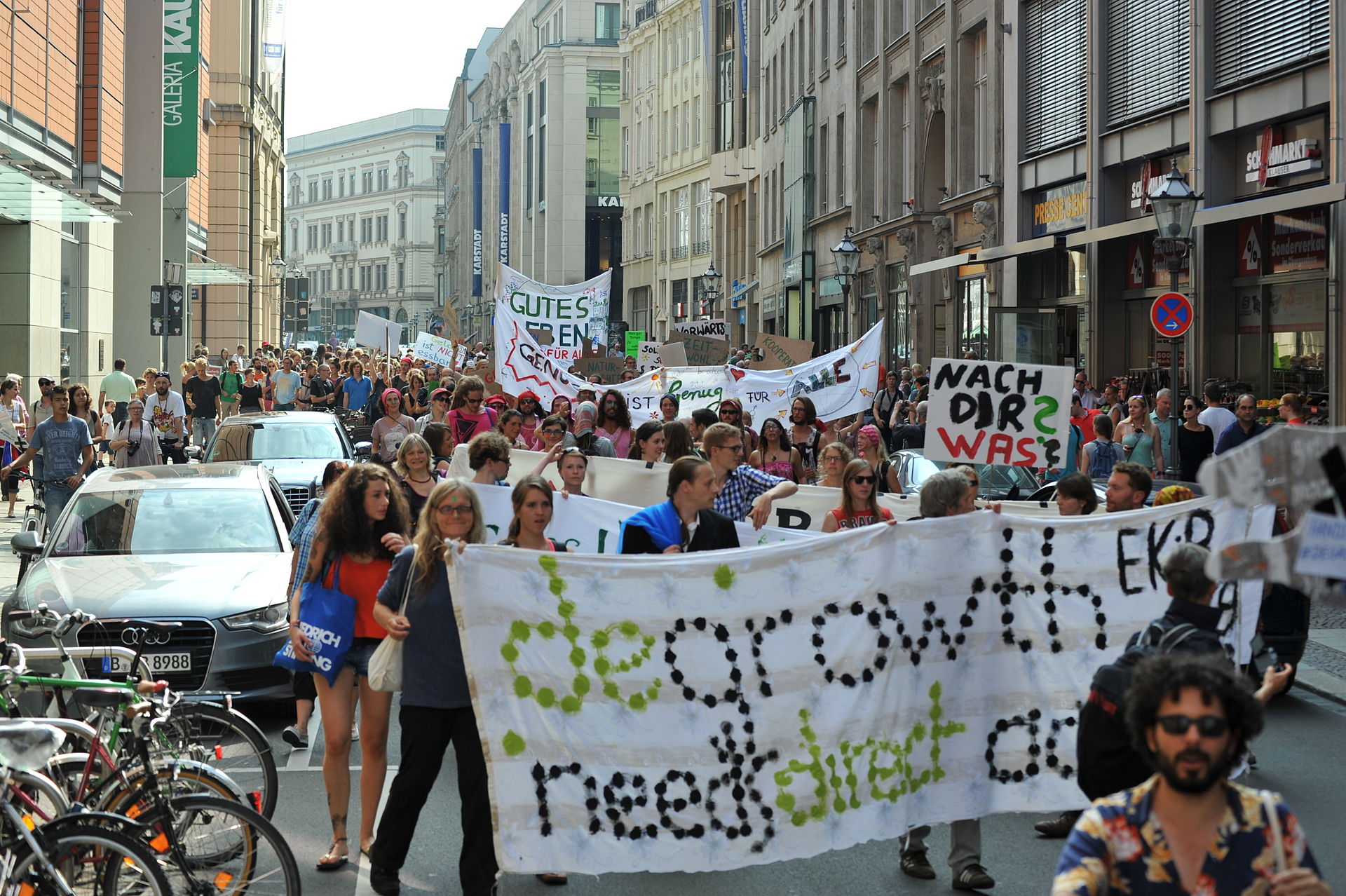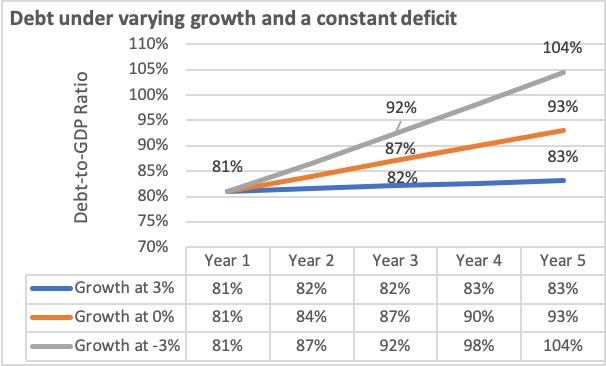
Debt and Degrowth: Dynamics of Deficits under Zero Growth
20 August, 2020
Infinite growth is impossible in a finite world.
In the words of ecological economist Giorgos Kallis, “if humanity is not to destroy the planet’s life support systems, the global economy should slow down.” This simple premise is the seed of a new school of ecological economics – “degrowth” which aims to disrupt many of the traditional assumptions around economic growth.[i]
In Kallis’ manifesto, “In Defense of Degrowth”, it is defined as an “equitable downscaling of production and consumption that increases human well-being and enhances ecological conditions.”[ii] This would require societies to operate within their ecological means as localized economies and distributing resources equally by creating new democratic institutions. In this way, these “societies will no longer have to ‘grow or die.”[iii] Degrowth’s central emphasis then is on renewing our relationship to the planet’s ecology and reducing economic activity to reach a sustainable equilibrium.
Spurred on by the threat of climate change and encouraged by the generalized economic malaise of the last decade, alternative economic thinking has grown in popularity; however, degrowth has struggled to emerge politically. Despite capturing the imagination of civil society, it has largely been excluded from the policy agendas of national governments, residing mainly in the radical wings of European green parties.[iv]
One barrier to widespread adoption, even amongst political parties sensitive to climate concerns, may be certain tensions in their policy toolbox. A policy instrument shared by parties across the progressive spectrum, from moderate social democrats to radical socialists, is heightened public spending. This could take the form of ambitious proposals for public ownership, Keynesian countercyclical spending, or simply greater levels of public investment in social services (e.g. health or education).
These state-led proposals to address pressing social needs are often financed through higher taxes and – most importantly – they often incur public debt. Not deaf to ecological concerns however, the Left often marries this heightened investment within an overreaching desire to generate sustainable or “green growth.” And yet, this debt-driven (green)investment-growth path may generate tensions which become clearer when assessing practical visions of sustainability.
Two Visions for a Carbon Neutral Future
A progressive vision for green growth could be understood by looking at the European Green Deal (EGD). The European Commission describes it as a:
“roadmap for making the EU’s economy sustainable” through a “new growth strategy that aims to transform the EU into a fair and prosperous society, with a modern, resource-efficient and competitive economy where there are no net emissions of greenhouse gases in 2050 and where economic growth is decoupled from resource use.”
The monumental task of transforming the EU’s economy requires redirecting enormous amounts of public and private investments towards climate and environmental activities. For example, a European Parliament resolution on climate change in March 2019 estimated that reaching a net-zero greenhouse gas economy would require an additional investment of 175 to 290 billion euros in the energy system alone. While the gains of this investment are often justified in additional GDP generated, the hope that future growth can somehow be decoupled from the overuse of the world’s resources may be overly optimistic.
EGD policy documents note that between 1990 and 2019, the EU “reduced greenhouse gas emissions by 23%, while the economy grew by 61%.” However, the Climate Works Foundation argues that when accounting for carbon consumption rather than just production, European greenhouse gas emissions actually increased 11% from 1995 to 2009.
Similarly, the same policy documents note that annual global extraction of materials have tripled between 1970 and 2017 and that globally, we consume 42bn tonnes over the planet’s estimated maximum annual resource use of 50bn tonnes. The difficulty with green growth, according to the economist Jason Hickel, is that raw material consumption closely follows GDP growth. The EU’s recently announced Circular Economy Action Plan as part of the EGD aims to break this relationship – but its effects remain to be seen.
In another paradigm, the City of Amsterdam is working towards a different model of sustainability, by using the ‘doughnut’ model as their framework for all public policy decisions. The doughnut model was popularized by Kate Raworth, economist and author of “Doughnut Economics: Seven ways to Think Like a 21st Century Economist.” Drawing upon a degrowth vocabulary, she states that “the goal of economic activity should be about meeting the core needs of all but within the means of the planet.”
In her model, the economy is conceptualized as a series of rings. The inside ring is the “social foundation for a good life, including income, work, health, social networks and political participation.” The outside ring signifies the “ecological limits of the planet, such as climate change, ozone layer depletion and a decline in biodiversity.” In between the social minimum and the ecological maximum is the ideal equilibrium – “where everyone’s needs, and the planet’s, are being met” in both a welfare maximizing and sustainable way.
In concrete terms, this means Amsterdam would address core policy issues, such as housing affordability, with the additional lens of ecological responsibility. Affordability is a serious issue in Amsterdam where almost 20% of renters struggle to meet their basic needs after paying rent. Yet under this new approach, when addressing housing supply by building more homes, they must also reconcile that importing building materials, food and consumer products makes up 62% of their emissions – which is still 31% above 1990 levels. Therefore, the proposed solution in their Circular Strategy 2020-2025 is to adopt regulations that ensure builders turn to recycled and bio-based building materials, such as wood.
While these visions of green growth (e.g. EGD) and degrowth (e.g. the doughnut model) may appear compatible, there are inherent tensions between green growth’s preferences for deficit-financed investment and degrowth’s desire to responsibly curtail consumption and production. The tension of interest arises from the dynamics of debt. Simply put, investments can either be financed through existing savings, or by reducing current consumption or debt (an obligation for future repayment). When investment is financed by debt, it is logically premised on the hope that investments will yield larger returns in the future, making payment easier.
Growing the Deficit, Shrinking the Economy
This logic similarly applies to public finance. There are many reasons for a state to incur debt to finance spending, but the clearest demonstration of this dynamic is Keynesian fiscal policy, often adopted by progressive parties. Roughly speaking, if the economy is below its potential, the government should increase spending to boost aggregate demand, which spurs the circulation of money in the economy. This countercyclical fiscal policy allows a government to return an economy in recession back to growth – an event we are witnessing today as governments across Europe boost spending to counter the COVID-19 recession.
Deficit-financed fiscal policy is often conducted explicitly on the return to growth. A larger future economy will both reduce the need for spending and generate more tax revenue, allowing for a deficit to revert to a surplus. Deficit spending in conditions of zero-growth or degrowth would activate a very difficult dynamic. This dynamic can be seen in the Debt-to-GDP ratio, a common statistic used to understand the relative size of a government’s debt.
The following example (Figure 1) demonstrates the effect a constant deficit could have on a state’s public finances under different GDP growth scenarios. Represented are the effects of different growth rates on Germany’s Debt-to-GDP ratio under a fixed deficit of 3% of GDP over a five-year horizon. Under a 3% GDP growth rate, the effect is marginal; but under a negative growth of 3%, the effect is significant and would quickly fall afoul of the fiscal rules of the monetary union (Europe’s Economic and Monetary Union entrenches a debt-load target of 60% of GDP through the Stability and Growth Pact).

Although these perimeters are static and fictitious, the dynamic is clear: deficit-spending under compounding degrowth would be difficult to sustain under traditional macroeconomic assumptions. This also does not consider the effect of economic contractions on the deficit by lowering revenue in the form of a shrinking tax base and increasing spending costs through higher borrowing costs and greater use of social security programs.
Overall, the incentives, even for progressive politicians who may deeply care about the environment, are quite clear; deficit-financed investment will naturally encourage future growth to discourage harder decisions, including spending cuts or revenue increases.
This matters, as degrowth moves from an ambitious agenda into a practical program of government. If the degrowth movement wishes to uncritically accept the widely accepted default-Keynesian tendency of the Left, it may unwittingly fall victim to an incentive structure that will routinely push progressive politicians to seek expansionist growth.
Conclusions: The Political-Ecological Dynamics
There are multiple solutions proposed by Kallis and others to achieve this prosperity without growth: a shortened working week, a basic citizen’s income, hard caps on carbon emissions and extraction, curtailed financial speculation, a strengthened common sphere, debt restructuring, and removing GDP as a central indicator of progress. But the most central of them all may be their radical tax proposals, wherein rather than building public indebtedness to solve climate change, we instead conscript private wealth – often used for carbon intensive private consumption – to the public purpose of saving the planet.
Higher taxes on wealth, capital, and the highest earners would allow us to fund aggressive decarbonization, while severing the debt-growth spiral so central to the state’s support for the growth imperative (the tendency towards perpetual growth).
Parallels are often evoked with wartime planning and the need for extensive state-directed mobilization of an equivalent scale to counter the threat of climate change. The degrowth argument serves as a reminder that this conflict is not with an external enemy but is rather with our own human and flawed desire to consume evermore.
As the European Commission unlocks €750 billion of new Commission-backed funding through the Next Generation EU recovery package, we should be mindful not just of a debt trap, but of a growth trap. In Kallis’ words – “We were indebted to grow and now we are forced to grow to pay off debts.”
[i] Giorgos Kallis, “The degrowth alternative” in Giorgos Kallis, In Defense of Degrowth: opinions and minifestos. (published as Open Commons, March 2017).
[ii] Giorgos Kallis, “The degrowth alternative” in Giorgos Kallis, In Defense of Degrowth: opinions and minifestos. (published as Open Commons, March 2017).
[iii] Giorgos Kallis, “For a radical environmentalism” in Giorgos Kallis, In Defense of Degrowth: opinions and minifestos. (published as Open Commons, March 2017).
[iv] Giorgos Kallis, “The Left should embrace Degrowth” in Giorgos Kallis, In Defense of Degrowth: opinions and minifestos. (published as Open Commons, March 2017).